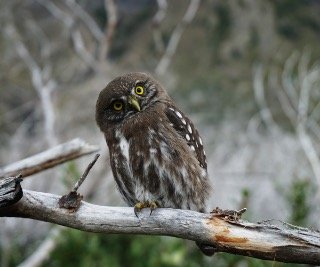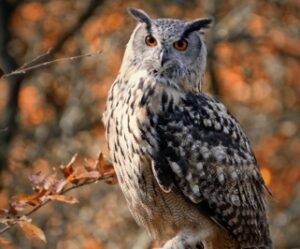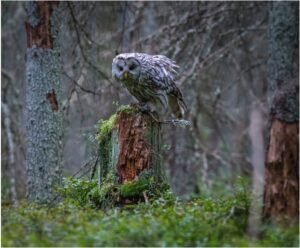
Owls in Indiana
In order to have the best chance of sighting owls in Indiana, head out to a wooded area early in the morning or late at night. Look for high perches on the border of the woodland that provide a view of wide grassland or pastures, as opposed to low perches.
In Indiana, there are six different types of owls:
- Barn Owl
- Great Horned Owl
- Barred Owl
- Long-eared Owl
- Short-eared Owl
- Northern Saw-whet Owl
Among the owl species found in Indiana, the Great Horned Owl is the largest, while the Northern Saw-whet Owl is the tiniest of the species.
Owls are predatory birds of prey that seek and eat a variety of food including small animals, amphibians, snakes, and insects. In most cases, owls consume their food whole, frequently after removing the head, and then vomit the bones and fur as waste.
Why Do Owls Hoot? All You Need To Know
1. The Barn owl
The Barn Owl can be observed throughout the year in Indiana, but they are not particularly numerous. This white-faced nocturnal bird is about the size of a crow, and it is completely silent.
- Length: 12.6-15.8 in (32-40 cm)
- Weight: 14.1-24.7 oz (400-700 g)
- Wingspan: 39.4-49.2 in (100-125 cm)

Barn Owls have white faces, chests, and bellies, as well as white underwings, and their backs are buff in hue. Their faces are round, and they have long, rounded wings and short tails.
Females have spots on their chests that assist to keep parasites at bay, and the more spots the female has, the more the male contributes to the nest’s construction!
In the evenings, they forage for small rodents over open land such as fields and meadows, earning the name “barn owl” since they frequently roost in barns during the day.
Listen Barn Owl Hoot:
Credit: Manceau Lionel, XC659876. Accessible at www.xeno-canto.org/659876.
Barn owls swallow their prey whole and cough out pellets twice a day. Because the Barn Owl has the finest hearing of any animal studied, it mostly hunts for prey by listening for sounds. This allows them to seize prey in complete darkness or when it is hidden beneath plants or in snow.
Sleeping Owls Are So Adorable: Pictures & Fun Fact
They make their nests in tree cavities, caves, and, more frequently, barns or other abandoned or quiet structures. Nest composed of regurgitated pellets that have been organized into a cup with the help of their feet.
They lay between 2 and 18 white eggs throughout the course of one to three broods. Barn Owls are found on all six continents and are represented by around 46 different species. They don’t hoot like other owls, instead emitting a scratchy screech call as a substitute.
2. The Great Horned Owl
The Great Horned Owl can be found throughout the year in Indiana, as well as throughout North America. They are huge owls with thick bodies and large tufts of feathers on their forehead that resemble ear tufts.
- Length: 18.1-24.8 in (46-63 cm)
- Weight: 32.1-88.2 oz (910-2500 g)
- Wingspan: 39.8-57.1 in (101-145 cm)

They are gray-brown in color, with a mottled pattern and a white patch on the throat. They have broad, rounded wings and a powerful hooting sound, which distinguishes them from other birds.
It is one of the most abundant owls in North America, and it may be found in a wide range of habitats, from woods to deserts, towns, and grasslands, among other places.
Listen Great Horned Owl Hoot:
Credit: Lance A. M. Benner, XC545009. Accessible at www.xeno-canto.org/545009.
For these fearsome hunters, prey includes birds and mammals that are much larger than they are themselves. They will also hunt other raptors, such as Ospreys, Peregrine falcons, and other owls, if the opportunity presents itself.
Are Owls Omnivores? Everything You Need To Know
Its varied food includes tiny rodents such as mice or skunks, as well as birds of prey such as geese and hares. It also contains insects, fish, and carrion. They are not picky eaters and will consume practically anything!
Great Horned Owls build their nests in trees, and they frequently use an abandoned nest from another species. They sometimes line their nests with bark, leaves, downy feathers, or pellets, although they also leave them unlined on occasion. They lay 1-4 white eggs per clutch.
3. Barred Owl
In Indiana, the Barred Owl can be found throughout the year. These huge, stocky birds are between the proportions of a crow and a goose in terms of stature.
- Length: 16.9-19.7 in (43-50 cm)
- Weight: 16.6-37.0 oz (470-1050 g)
- Wingspan: 39.0-43.3 in (99-110 cm)

Barred Owls are brown and white in color, with a mottled pattern of vertical stripes on their bellies and horizontal stripes on their backs and upper breast that is distinctive.
Owl Face: 19 Owl Species With Irresistible Faces
These owls have black eyes, a characteristic round head with no ear tufts, and a round tail. The Barred Owl communicates by making a loud barking hoo hoo call.
Listen Barred Owl Hoot:
Credit: wisconagus, XC691476. Accessible at www.xeno-canto.org/691476.
Their method of hunting for small animals, such as squirrels and rabbits as well as birds and voles, is to sit and watch from an elevated perch.
They dwell in huge, mature forests, frequently near bodies of water, and build their nests in tree cavities, where they deposit 1-5 white eggs per clutch.
4. Long-eared Owl
This species of owl can be found in Indiana during the winter after breeding and migrating from colder climates in the northern states and Canada. They are medium-sized owls that are about the size of a crow, and they have a shocked expression on their faces.
- Length: 13.8-15.8 in (35-40 cm)
- Weight: 7.8-15.3 oz (220-435 g)
- Wingspan: 35.4-39.4 in (90-100 cm)
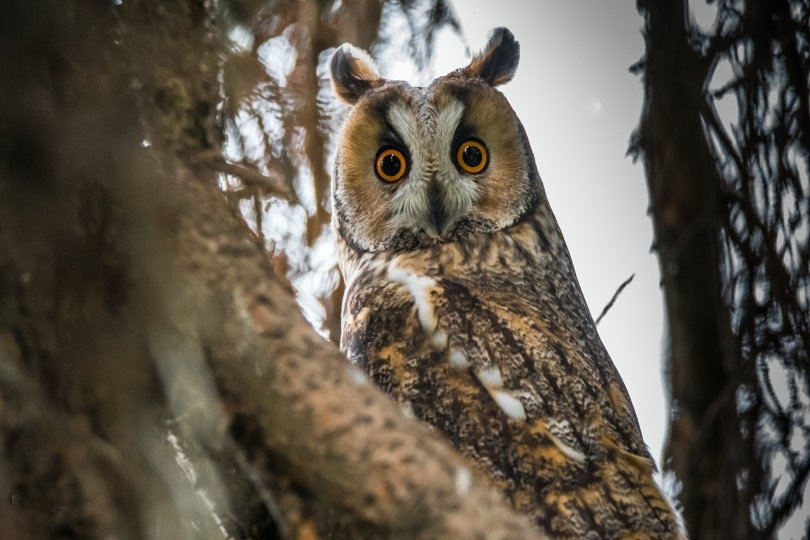
In addition to having patterned black and brown feathers, long-eared owls also have buff faces, big black or buff ear tufts, and yellow eyes.
6 Largest Owls In The World: Everything You Need To Know
They are nocturnal and roost in deep woodlands, where they can remain hidden while still being close to grassland where they can hunt. Small mammals such as voles, mice, juvenile rats, and rabbits are prey for Long-eared Owls.
Listen Long-eared Owl Hoot:
Credit: András Schmidt, XC699379. Accessible at www.xeno-canto.org/699379.
They hunt over broad grassland or pastures by hovering just a few feet above the ground and scanning or listening for signs of movement, which they can detect.
They lay between 2 and 10 white eggs in stick nests that have been abandoned by other species. Except during breeding season, long-eared owls are only occasionally heard. They communicate with gentle low hoots and whistles, whines, shrieks, and meows that sound like cats.
5. Short-eared Owl
The Short-eared Owl can be found in Indiana during the winter months after migrating from more northern states and Canada following nesting season. Approximately the size of a crow, they have extremely little ear tufts and are medium-sized in overall appearance.
- Length: 13.4-16.9 in (34-43 cm)
- Weight: 7.3-16.8 oz (206-475 g)
- Wingspan: 33.5-40.5 in (85-103 cm)
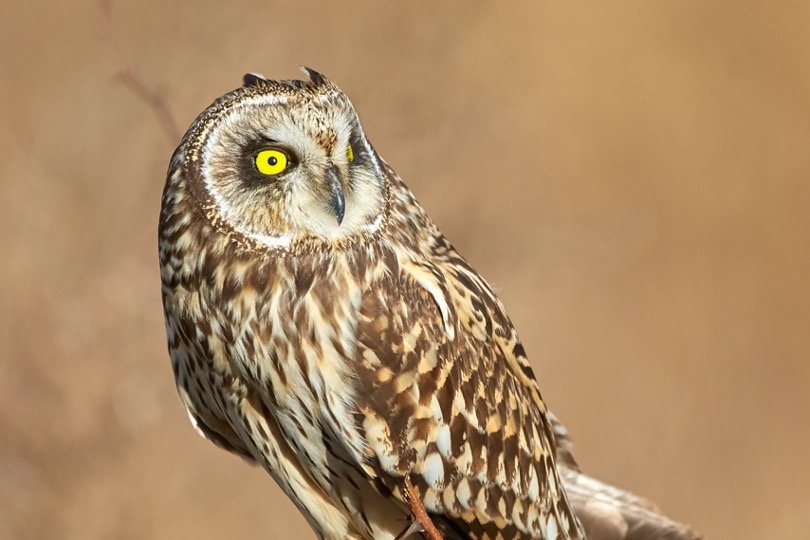
Short-eared Owls are distinguished by their mottled black, brown, and white coloring, as well as their pale cheeks and black-rimmed yellow eyes.
Baby Owl Sleeping Face Down Is Unbelievable (With Picture)
A short tail is attached to the end of their large wings, which have a rounded tip. The Short-eared Owl, in contrast to most other owls, hunts during the day, primarily around dawn and dusk.
Listen Short-eared Owl Hoot:
Credit: Romuald Mikusek, XC669188. Accessible at www.xeno-canto.org/669188.
It is their prey, small mammals such as voles and mice, that they hunt, and they fly low over the ground, searching and listening for movement. It is also noteworthy that short-eared owls construct their own nests by scraping the ground into a bowl and lining it with grass and soft feathers.
They lay between 1 and 11 cream or white eggs per clutch. They are not extremely loud, although the males will produce approximately a dozen hoots during courtship, and when guarding the nest, they may bark, whine, or scream.
6. Northern Saw-whet Owl
During the winter, the Northern Saw-whet Owl can be found in Indiana. This little owl is roughly the size of a robin.
- Length: 7.1-8.3 in (18-21 cm)
- Weight: 2.3-5.3 oz (65-151 g)
- Wingspan: 16.5-18.9 in (42-48 cm)
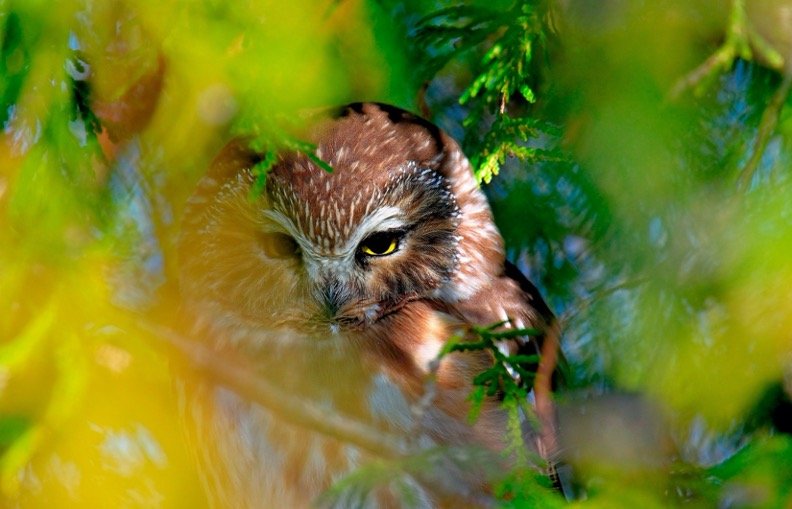
The Northern-Saw-whet Owls have small bodies and huge spherical heads, which distinguish them from other birds. This species is brown with white markings on its face, a spotted head, and yellow eyes.
Listen Northern-Saw-whet Hoot:
Credit: Lance A. M. Benner, XC446701. Accessible at www.xeno-canto.org/446701.
They are nocturnal hunters who reside in deep woodlands, where they prey on small mammals, particularly mice. They build their nests in tree cavities that have been left by other species, such as Pileated Woodpeckers, over the years.
Where Do Owls Nest? Everything You Need To Know
They don’t use any additional nesting material and instead deposit their eggs right on the garbage. They lay between 4 and 7 whitish eggs.
